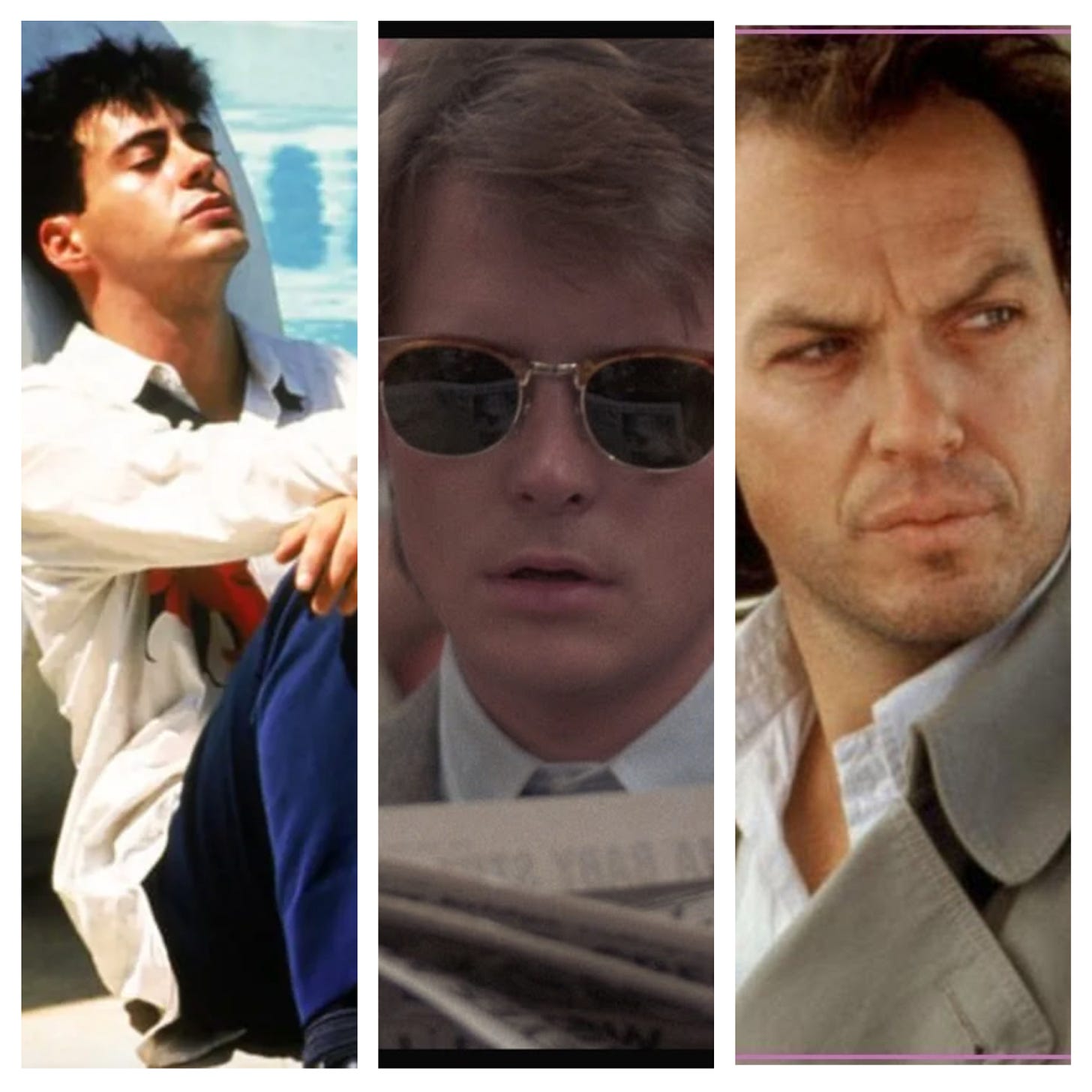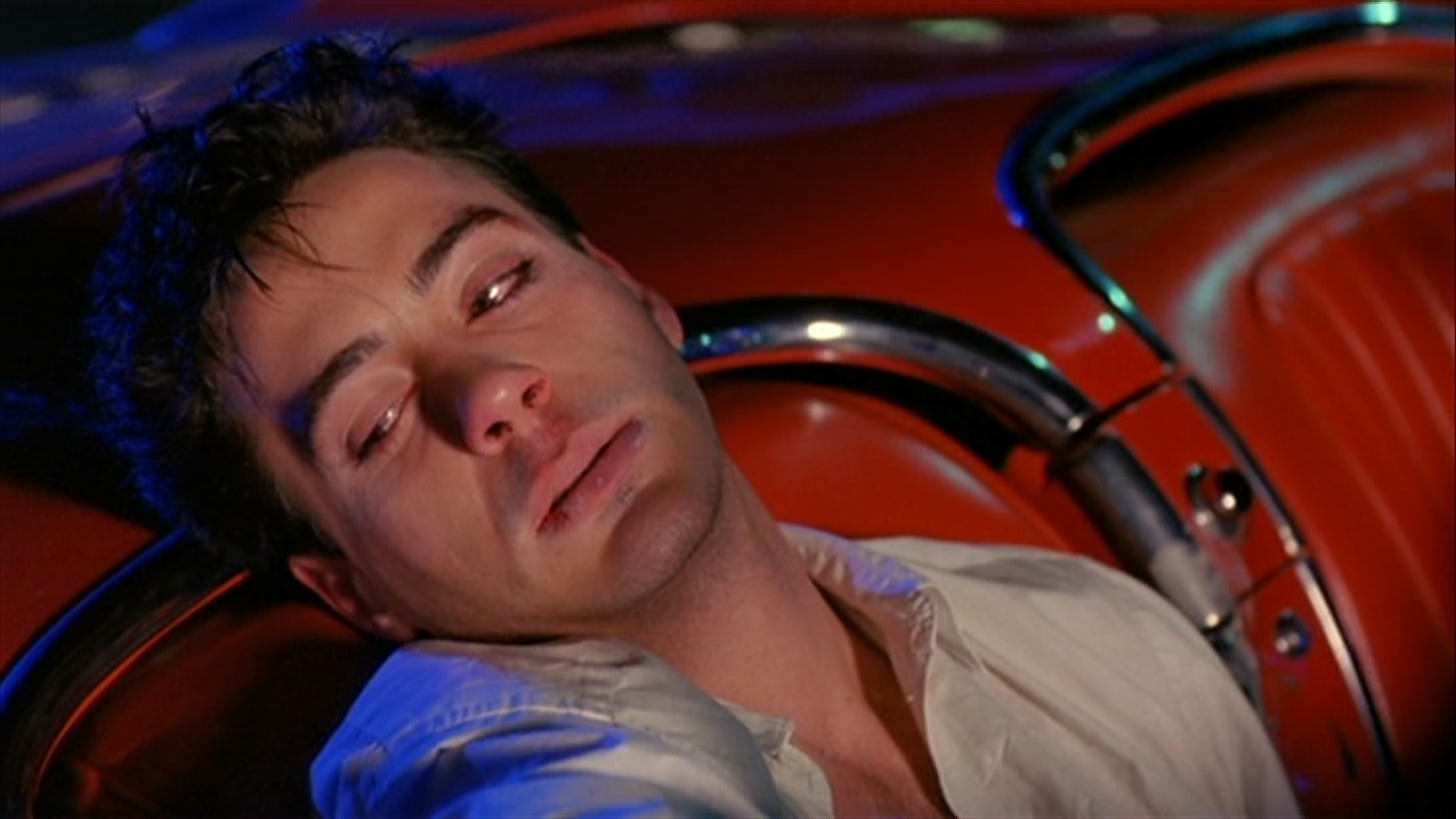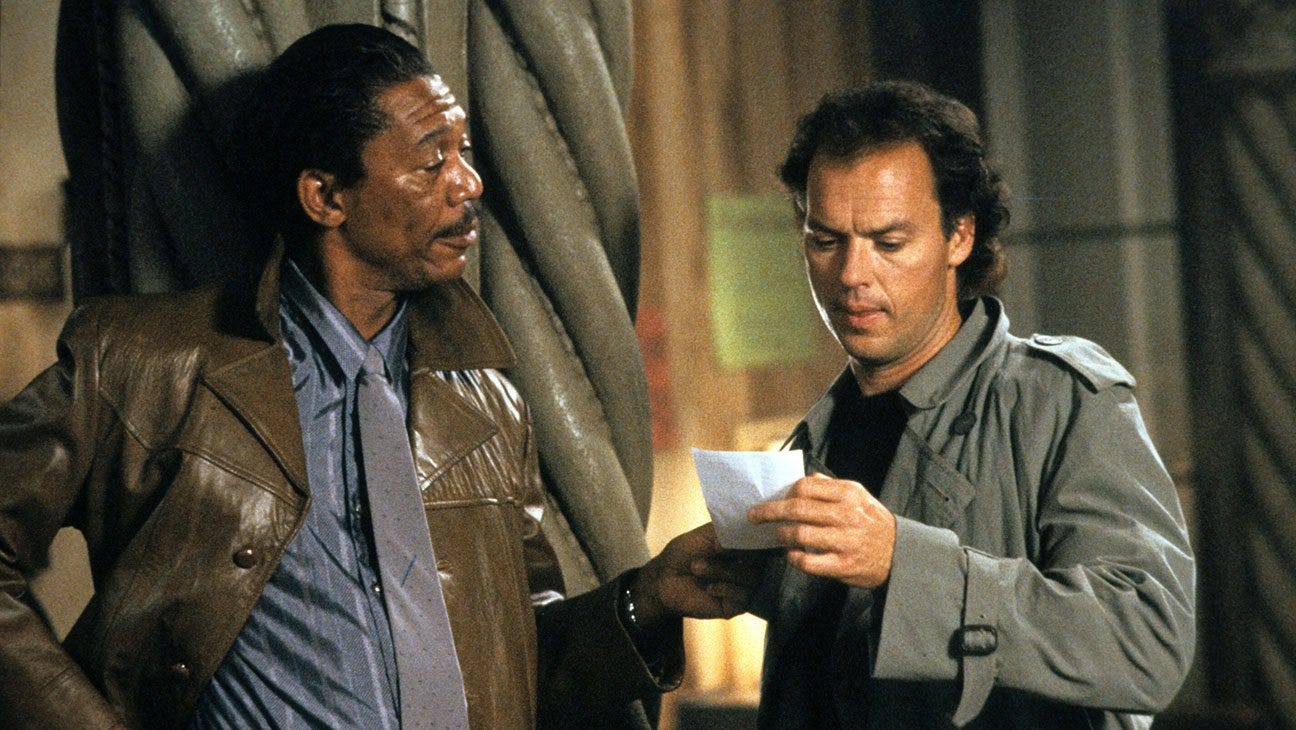Hollywood's Brief Cocaine Binge
In the late '80s, as the Reagan years were winding down, three movies tried to mark the dark side of runaway excess.
“That’s the stock market, babe. It doesn’t give a fuck if I’m in a hospital or not.” — Michael Keaton, Clean and Sober
“Rain—fog—cancelled horse back ride. Did my radio cast on Hurricane “Gilbert” & the Olympics in S. Korea. Most of day finished reading my homework. After dinner—watched a long & not very entertaining movie about a man fighting drugs.” — Ronald Reagan’s White House Diary, 9/17/1988
It would not be strictly accurate to claim that Hollywood was on the lookout for cocaine narratives in late 1987 and 1988, when Less Than Zero, Bright Lights, Big City, and Clean and Sober were all released several months apart, creating a perfect capper to the “Just Say No” era as Ronald Reagan’s administration was winding down. And audiences were definitely not on the lookout for cocaine narratives, either, because all three films followed poor-to-respectful reviews to anemic box-office performances. Less Than Zero and Bright Lights, Big City were hot literary properties first and foremost, debut novels by two writers, Bret Easton Ellis and Jay McInerney, respectively, who seemed to have their fingers on the toot-quickened pulse of American youths. At the time, studios still liked to take small gambles in the hopes of finding the next Rebel Without a Cause or The Graduate, and Ellis and McInerney might know something they didn’t. Clean and Sober was more a case of a rising star, Michael Keaton, stretching out into more dramatic terrain and perhaps seeming like a good match for director Glenn Gordon Caron, who’d created Moonlighting and might harness his combustible energy.
And yet, taken together, all three films make for a fascinating time capsule, each grappling with a decade of conspicuous consumption, where cocaine represented another lifestyle accessory, like a nigiri maker you could shoot up your nose. In their often immensely flawed ways, they tried to measure the hangover at the end of the party, when the fun—or the ritualistic appearance of fun, anyway—stopped and there were consequences to face in the cold light of day. Because cocaine is a drug mostly reserved for the white and well-to-do, there would be no tours of the crack dens we’d see a short time later in films by Black directors, like Jungle Fever and New Jack City. This was an addiction specifically connected to ‘80s decadence, when young professionals chasing success needed marching powder to feed what McInerney called “the brigades of tiny Bolivian soldiers” that got hungrier and hungrier.
A cynical person might say that the spike of interest in cocaine stories, as opposed to humbler stimulants, reflected Hollywood’s narrow compassion for one of its own—the Beverly Hills rich kid who partied too hard, the would-be literary superstar inadvertently creating material for his future memoir, the real-estate hotshot who found himself underwater. It was a fall from grace that would have been familiar in elite circles, where some of the people who excused themselves to snort discreetly in bathroom stalls never came back to the party. But there’s also a larger statement in these films about where this culture of unfettered capitalist excess had led some who seemed to benefit from it most. They’re about various stages of addiction and recovery (or death), but they’re also about existential ennui, with characters searching for meaning that drugs can’t supplement. The decade was ending in one of Andrew McCarthy’s patented thousand-yard stares.
***
The worst of the three, Less Than Zero certainly has a sense of its own significance, opening with a graduation speech set against the slow-motion flapping of an American flag and a cry of “We want money” coming from the seniors. With fat trust funds and distant parents, these graduates are the sorts of L.A. teenagers who have pretended to be adults for so long that they can suck open bottles of champagne after the ceremony and nobody bats an eye. Among his trio of friends, Clay (McCarthy) is the most conventional, one of many alterations to Ellis’ book, which cast him more as a disaffected pleasure-seeker who drifted from party to party, doing drugs and scoring with both men and women. Here he’s a terminal wet blanket who spends a chilly fall in an elite eastern college and comes home for Christmas to find his friends in turmoil.
The speed with which his girlfriend Blair (Jami Gertz), an aspiring model, and his best friend Julian (Robert Downey, Jr.), have spiraled into cocaine addiction and an ill-advised sexual relationship is almost comical—or would be, if it didn’t seem so inevitable. Blair and Julian both had plans after high school, with Blair’s modeling career finding a little bit of traction and Julian’s daddy-funded ambitions as a music mogul going belly up, but nothing to take them away from the succession of parties that fuel their addiction while emptying their pockets. McCarthy’s inscrutable performance makes it hard to tell how he feels about the affair—he’s unhappy, but a little blasé, as if he expected it to happen—but it doesn’t drive him away from them. He’s almost a stand-in for their absent parents, the disappointed father who’s nonetheless obliged to save them from themselves, even though he wonders if they’re too far gone. They cling to him like children, too, terrified by the thought that he will leave them again when Christmas break is over.
Turn down the dialogue track and you can almost convince yourself that Less Than Zero is a great movie, because the visual texture and the soundtrack feel utterly alluring and persuasive. Director Marek Kaniesvska is a Polish filmmaker who got the job mostly on the strength of his commercial work—he was part of Ridley and Tony Scott’s production company—and the brilliant cinematographer Ed Lachman draws out the shimmering surface appeal of house parties that feint at Christmas cheer, but emphasize the cold, unforgiving modern spaces these characters occupy. The Rick Rubin-produced soundtrack does a lot of the heavy lifting, too, particularly the Bangles’ cover of Simon & Garfunkel’s “Hazy Shade of Winter” that perfectly captures the Christmas-in-L.A. surreality and a closing credits song, Roy Orbison’s “Life Fades Away” (written by Glenn Danzig!), that’s more moving than anything in the film. (Personal aside: Less Than Zero was one of the movies played at Cobb Place 8 in 1987 when I got my first job as an usher and I loved cleaning up after that film, because the song was so beautiful… and because the film was lightly attended.)
McCarthy and Gertz anchor Less Than Zero in the worst sense of the word, and the edgelessness of the adaptation, which only teases at the debauchery that gives Ellis’ work its potency, gives it the feel of an old-fashioned, unhip morality tale. (The good-and-nasty The Rules of Attraction, from 2002, is an Ellis adaptation done right, though many critics found it off-putting.) But it was a breakthrough performance for Downey, who’d been the manic jester of comedies like Weird Science and Back to School, but channels that energy (and some personal experience) to much darker effect here. His Julian has an impish charm that makes him simultaneously ingratiating and exasperating, the type of guy that keeps getting chances from people who know he’s going to blow them. Better still is James Spader as Rip, a cocaine dealer who prowls the scene with a sleek malevolence that makes him seem like the Grim Reaper of Beverly Hills. They deserve a better movie.
***
The common problem connecting Less Than Zero to Bright Lights, Big City is that neither Ellis’ novel nor McInerney’s has much life off the page. They got attention as showy feats of writing—McInerney’s book is written entirely in second person, a device the film only deploys intermittently in the voiceover narration—but their stories are largely internal, staying close to a single character who’s processing a difficult period in his life. There’s not much of a film there, in other words, that can be rendered as something other than a banal addiction story set against one cool coastal scene or another. That suggests a second problem, too, with bringing these stories to the screen: They’re ostensibly cautionary tales about the ruinous effects of cocaine, but they are also aspirational models for an audience that might dream of nightclubs or literary soirees.
Casting again becomes a major issue here with Michael J. Fox stepping in as McInerney’s alter-ego Jamie Conway, a 24-year-old fact-checker at a New Yorker-like magazine whose greater ambitions are waylaid by a failed marriage and his mother’s recent death from cancer. Fox was still logging time in the later seasons of Family Ties, despite his small-screen breakout role leading to the big-screen success of Back to the Future, but his boyishness seems mostly out of place in Bright Lights, Big City, other than in his ability to convince other characters to give his terminal fuck-up another chance. The scrupulousness required of Jamie in his fact-checking job doesn’t square with a nocturnal lifestyle that leaves him wired and sleepless, coming to work late after long nights snorting coke and chasing skirts with his sleazy friend Tad (Kiefer Sutherland). He becomes a more salvageable version of Julian in Less Than Zero, someone who falls into debt while spiraling into addiction.
One of the benefits of having an actor as likable as Fox, however miscast he might be, is that you’re less likely to ask a basic question like, “Why should I care about this guy?” There’s at least some attempt to answer the question through crude flashbacks to his marriage to a vacuous social climber (Phoebe Cates) and him tending to his mother (Dianne Wiest) in the last moments of her life, but so many of Jamie’s problems are self-afflicted and the film doesn’t seem wholly aware of it. It makes a villain out of Jamie’s boss at the magazine, who’s presented as an awful harridan for insisting that he do his job up to the publication’s high standards. Swoosie Kurtz is excellent as a co-worker who takes an almost motherly role in looking after Jamie, but the dynamic is a little like Shattered Glass if Stephen Glass’s co-workers never stopped vilifying their editor-in-chief, even after Glass was revealed to be a fraud. He fully deserves to get fired.
After multiple attempts to bring Bright Lights, Big City to the screen, with a host of what-if directors (Ulu Grosbard and Bruce Beresford were the others), the job went to James Bridges, whose spotty filmography included a couple of winners in The Paper Chase and The China Syndrome, but never suggested the zip required of a cocaine story. There are attempts here to emphasize Jamie’s demented headspace, like a running bit involving a “coma baby” story in the New York Post, but the film is a mostly staid drama that misses the after-hours lifestyle that pushes Jamie into the night. It is terminally uncool for one, and it backs away from the consequences of Jamie’s addiction, which mostly gets him out of a job he doesn’t like, a marriage that was never going to work, and a friendship with a creep who never had his best interests in mind. His problems are easily solved.
***
No so for Daryl Poynter (Michael Keaton) in Clean and Sober, who ends a 30-day odyssey with a sobriety chip that’s well-earned and still only tenuously grasped. By far the strongest and most emotionally pungent of the three, the film starts with Daryl more fully under the grip of cocaine addiction than Julian or Jamie, and only accidentally more serious in trying to get it under control. Director Glenn Gordon Caron, working from a script by former National Lampoon writer Tod Carroll (O.C. and Stiggs), wastes no time in plunging the film into crisis and accounting for the cause of his situation later. All we know is that Daryl was once a successful real estate salesman from Philadelphia who embezzled $92,000 from a company escrow account to work the stock market and feed his raging cocaine habit.
There’s a potent irony at the center of Clean and Sober that supercharges the film: Daryl admits himself to a drug rehabilitation program, but only because a radio ad for it guarantees patient anonymity, which will allow him to a place to hide out where his bosses and creditors can’t find him. In other words, he schemes his way into recovery more than he pursues it. The film never gets better than in his earliest days at the facility, when he realizes that the price for hiding out means dealing with the agony of 48-hour detox and a humbling socialization process that puts him on par with other addicts and under the eyes of a counselor (Morgan Freeman) who has him pegged. His priority is always to slip away for phone calls to put out various fires on the outside, not realizing that he’s well behind the other patients in confronting a habit that’s eating him alive.
At the time, Keaton was an ascendant spark plug of an actor in Hollywood, having carried lead roles in films like Night Shift, Mr. Mom, Johnny Dangerously, and Gung Ho, but he hadn’t had much of an opportunity to test his dramatic chops. Ditto Caron, who’d made Moonlighting a hit on television, but was clearly eager to stretch out in his directorial debut. Keaton and Caron bring the hyper-caffeinated energy to Clean and Sober than the other two films lack while also taking addiction much more seriously. There’s no attempt here to play for a younger crowd, but a real sincerity about the speed at which cocaine can gobble up a person’s money and future at terrifying speed. Keaton’s twitchy persona is a good fit for the character, who’s older than someone like Downey’s Julian and vulnerable in a different way.
Clean and Sober can’t quite sustain tension once Daryl leaves rehab and tries to fumble his way back into reality, though it does have a nice turn from Kathy Baker as a fellow addict who’s locked into a codependent relationship with an abusive boyfriend. But it might be most notable for M. Emmet Walsh, one of the greatest character actors of his time, getting the space to deliver a performance of devastating sensitivity and insight. Walsh opens the film with an evocative AA monologue about watching the headlights for his dealer and his character’s wise counsel as Daryl’s sponsor comes from hard experience and a willingness to be patient. He is the face of a successful 12-step program—sympathetic and non-judgmental, but stern when he needs to be—and the tentative breakthrough Daryl experiences owes something to him. Ronald Reagan may have been bored by this portrait of a problem that flourished under his watch, but Clean and Sober works toward a hopeful future without him.








I'm glad you also called out the much different (and extremely less glamorous) way cocaine addiction is handled in the Crack Cinema of 1991: NEW JACK CITY, JUNGLE FEVER ... and I'd include BOYZ IN THE HOOD here, too. Much like the discrepancy in drug sentencing laws for powder vs crack cocaine offenses, characters depicted suffering from crack addiction almost never got their own movie (2006's HALF NELSON a notable exception) and were mainly confined to squalor, poverty and presumably, death.
BLBC was the first novel I read that was written entirely in the second person, and even though it is rather gimmicky in retrospect, as a high schooler, I thought it was cool. I was working at Barnes & Noble at the time (my senior summer), and I was getting acquainted with those fancy Vintage Contemporaries paperbacks (https://www.goodreads.com/list/show/14477.Best_of_Vintage_Contemporaries). I also just remembered: Spy made a very funny parody of Cliffs Notes of these hip, young novelists:
https://archive.org/details/spynotesonmciner00newy
As far as the movies go, I've seen both BLBC and LTZ, but not Clean and Sober. Barely passing grades to BLBC and LTZ for sure. I remember feeling quite bad for Downey, because it looked like he was living that poor character's life in his real life.